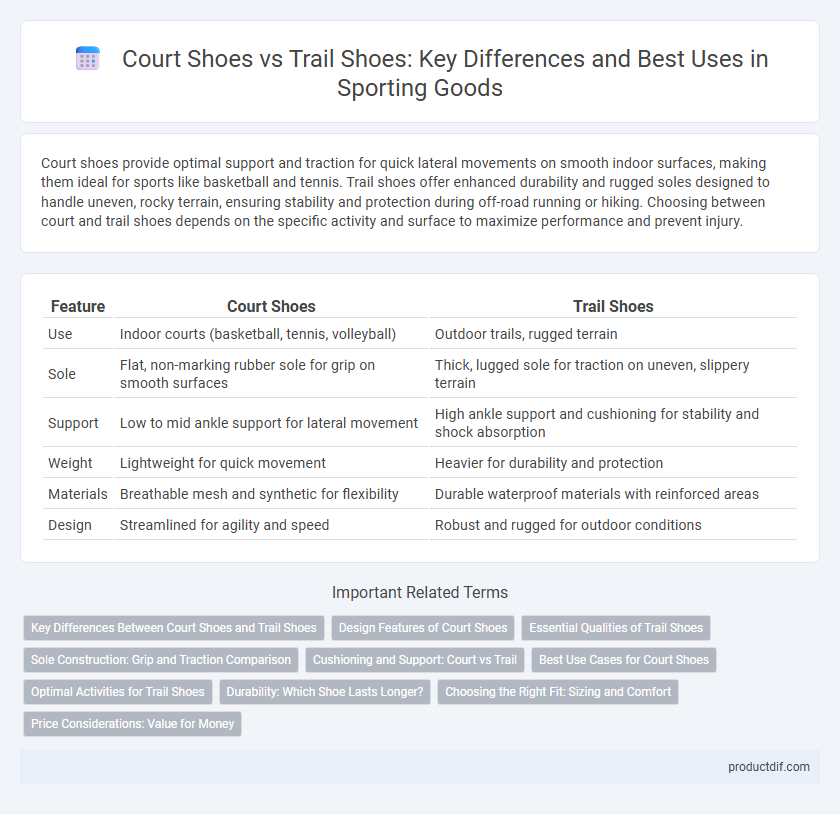Court shoes provide optimal support and traction for quick lateral movements on smooth indoor surfaces, making them ideal for sports like basketball and tennis. Trail shoes offer enhanced durability and rugged soles designed to handle uneven, rocky terrain, ensuring stability and protection during off-road running or hiking. Choosing between court and trail shoes depends on the specific activity and surface to maximize performance and prevent injury.
Table of Comparison
| Feature | Court Shoes | Trail Shoes |
|---|---|---|
| Use | Indoor courts (basketball, tennis, volleyball) | Outdoor trails, rugged terrain |
| Sole | Flat, non-marking rubber sole for grip on smooth surfaces | Thick, lugged sole for traction on uneven, slippery terrain |
| Support | Low to mid ankle support for lateral movement | High ankle support and cushioning for stability and shock absorption |
| Weight | Lightweight for quick movement | Heavier for durability and protection |
| Materials | Breathable mesh and synthetic for flexibility | Durable waterproof materials with reinforced areas |
| Design | Streamlined for agility and speed | Robust and rugged for outdoor conditions |
Key Differences Between Court Shoes and Trail Shoes
Court shoes are designed with non-marking rubber soles and enhanced lateral support to provide stability and grip on smooth indoor surfaces such as basketball or tennis courts. Trail shoes feature rugged, durable outsoles with deep lugs for superior traction on uneven, rocky outdoor terrain and often include reinforced toe caps for added protection. The key differences lie in sole design, cushioning, and durability tailored to the specific demands of indoor court sports versus outdoor trail activities.
Design Features of Court Shoes
Court shoes feature durable, non-marking rubber soles designed for optimal grip on indoor surfaces such as basketball or tennis courts, enhancing lateral stability and quick directional changes. Their lightweight construction includes reinforced toe caps and supportive midsoles to protect against sudden stops and pivots common in court sports. Breathable mesh uppers and padded collars improve comfort and ventilation during intense, fast-paced play.
Essential Qualities of Trail Shoes
Trail shoes feature enhanced traction with aggressive outsoles designed for uneven, rugged terrains, ensuring stability and grip on dirt, rocks, and mud. They incorporate durable, water-resistant materials and reinforced toe caps to protect feet from environmental hazards and debris. Cushioning and support systems in trail shoes absorb shock effectively, providing comfort and reducing fatigue during extended outdoor activities.
Sole Construction: Grip and Traction Comparison
Court shoes feature smooth, non-marking rubber soles designed for optimal grip on indoor surfaces like hardwood or synthetic courts, providing precise traction for quick lateral movements. Trail shoes incorporate rugged, multidirectional lugs made from durable rubber compounds to enhance traction on uneven, slippery, and rugged terrains, ensuring stability and preventing slips during outdoor activities. The sole construction differences directly influence performance, with court shoes prioritizing agility and trail shoes emphasizing durability and grip on challenging surfaces.
Cushioning and Support: Court vs Trail
Court shoes feature enhanced lateral support and firm cushioning tailored for quick, multidirectional movements on hard, flat surfaces, ensuring stability during sports like basketball and tennis. Trail shoes provide thicker, more rugged cushioning combined with reinforced arch support to absorb impact and protect feet on uneven, rocky terrain. The design differences prioritize stability and shock absorption specific to the demands of court versus trail environments.
Best Use Cases for Court Shoes
Court shoes excel in providing excellent lateral support and stability, making them ideal for sports like basketball, tennis, and volleyball that require quick lateral movements and abrupt stops. Their non-marking soles ensure optimal traction on indoor surfaces, preventing slips and preserving court quality. Designed with lightweight materials and cushioning, court shoes enhance agility and reduce impact stress during intense, fast-paced gameplay.
Optimal Activities for Trail Shoes
Trail shoes are specifically designed for off-road activities such as hiking, trail running, and rugged terrain exploration, offering enhanced grip, durability, and protection against rocks and uneven surfaces. Their reinforced soles and aggressive tread patterns provide superior traction on dirt, mud, and rocky paths, making them ideal for outdoor enthusiasts navigating natural trails. Lightweight yet sturdy construction ensures stability and comfort during long-distance outdoor adventures, differentiating them from court shoes used mainly for indoor sports.
Durability: Which Shoe Lasts Longer?
Court shoes are designed with durable rubber soles and reinforced toe areas to withstand the abrasive surfaces of indoor courts, making them highly resistant to wear and tear during lateral movements. Trail shoes feature rugged outsoles with aggressive lugs made from durable rubber compounds developed to endure rough, uneven terrain and resist abrasions from rocks and roots. While court shoes excel in longevity on smooth hard courts, trail shoes typically offer superior durability for outdoor use on challenging trails and varying weather conditions.
Choosing the Right Fit: Sizing and Comfort
Court shoes offer snug, precise fits with enhanced lateral support ideal for quick, multidirectional movements on hard surfaces, while trail shoes emphasize cushioning and a more spacious toe box to accommodate uneven terrain and foot swelling during extended hikes. Sizing for court shoes often runs true to standard measurements, prioritizing a secure fit to prevent slipping, whereas trail shoes may require sizing up for comfort and to avoid pressure points caused by rugged trails. Selecting the right fit hinges on assessing foot width, arch support needs, and intended activity type to ensure optimal comfort and performance.
Price Considerations: Value for Money
Court shoes typically offer excellent value for money due to their specialized design for indoor sports, providing durability and support at a moderate price point. Trail shoes often come at a higher price because of their rugged construction, enhanced grip, and weather-resistant materials that justify the investment for off-road enthusiasts. Consumers should weigh the specific performance needs and durability factors against the price to determine the best value for their sporting activities.
Court Shoes vs Trail Shoes Infographic

 productdif.com
productdif.com